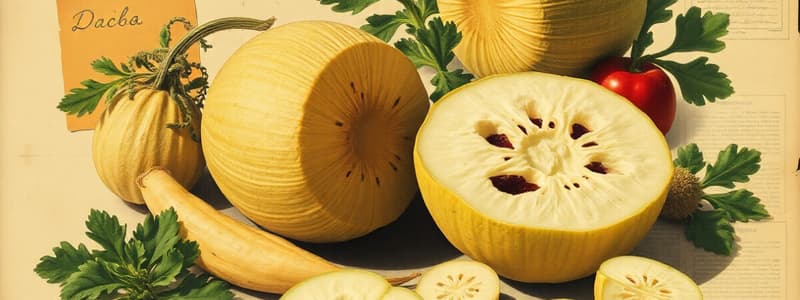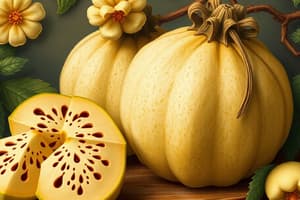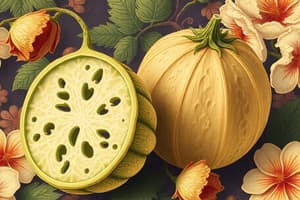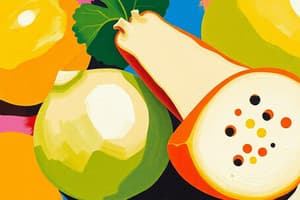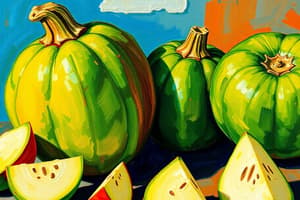Podcast
Questions and Answers
What type of plant is jicama classified as?
What type of plant is jicama classified as?
- Shrub
- Annual herb
- Herbaceous vine (correct)
- Woody perennial
Which part of the jicama plant is primarily utilized for food?
Which part of the jicama plant is primarily utilized for food?
- Tuberous root (correct)
- Flowers
- Stems
- Leaves
What processing step immediately follows harvesting jicama?
What processing step immediately follows harvesting jicama?
- Fermenting
- Peeling (correct)
- Cooking
- Cutting
In which regions of the world is jicama most widely grown and used?
In which regions of the world is jicama most widely grown and used?
How long does jicama typically live as a plant?
How long does jicama typically live as a plant?
Which part of the Jatropha plant is primarily harvested for economic uses?
Which part of the Jatropha plant is primarily harvested for economic uses?
What is the first step in the processing of Jatropha seeds after harvesting?
What is the first step in the processing of Jatropha seeds after harvesting?
For which of the following economic purposes is Jatropha primarily cultivated?
For which of the following economic purposes is Jatropha primarily cultivated?
What is the final processing step that can be performed on extracted oil from Jatropha seeds?
What is the final processing step that can be performed on extracted oil from Jatropha seeds?
Which of the following correctly defines a true root?
Which of the following correctly defines a true root?
Which of the following vegetables is not classified as a bulb?
Which of the following vegetables is not classified as a bulb?
What is the primary economic function of taproots?
What is the primary economic function of taproots?
Which of the following describes a corm?
Which of the following describes a corm?
Which part of green vegetable crops is harvested for consumption?
Which part of green vegetable crops is harvested for consumption?
What was one of the primary reasons spices were used in food during their early history?
What was one of the primary reasons spices were used in food during their early history?
Which event significantly contributed to the spread of spices to northern Europe?
Which event significantly contributed to the spread of spices to northern Europe?
What role did Venetian merchants play during the Fourth Crusade?
What role did Venetian merchants play during the Fourth Crusade?
What was a major outcome of Venice’s role in the Spice Trade?
What was a major outcome of Venice’s role in the Spice Trade?
Which spice was notably imported from regions like India and China during the Spice Trade?
Which spice was notably imported from regions like India and China during the Spice Trade?
What is the primary reason that starch is considered digestible while cellulose is not?
What is the primary reason that starch is considered digestible while cellulose is not?
Which statement accurately describes the role of amylase in starch digestion?
Which statement accurately describes the role of amylase in starch digestion?
What distinguishes bioethanol from traditional gasoline?
What distinguishes bioethanol from traditional gasoline?
What are the conditions under which ethanol is produced from sugar?
What are the conditions under which ethanol is produced from sugar?
Why is cellulose an important component of plant cell walls?
Why is cellulose an important component of plant cell walls?
What is a primary characteristic of trans fats as compared to unsaturated plant oils?
What is a primary characteristic of trans fats as compared to unsaturated plant oils?
Which part of a soap molecule is responsible for dissolving non-polar substances like grease?
Which part of a soap molecule is responsible for dissolving non-polar substances like grease?
What historical significance does the process of saponification have in soap making?
What historical significance does the process of saponification have in soap making?
What was a notable soap-making advancement made by Medieval Muslims?
What was a notable soap-making advancement made by Medieval Muslims?
Which ingredient was utilized in early castile soaps developed by Spain and Italy?
Which ingredient was utilized in early castile soaps developed by Spain and Italy?
What characteristic of biodiesel contributes to its classification as a renewable energy source?
What characteristic of biodiesel contributes to its classification as a renewable energy source?
Which type of oil is known to produce biodiesel with potential gelation issues in cold weather?
Which type of oil is known to produce biodiesel with potential gelation issues in cold weather?
Which of the following statements about canola is correct?
Which of the following statements about canola is correct?
What is the primary method of producing biodiesel from plant oils?
What is the primary method of producing biodiesel from plant oils?
Which plant oil has the highest potential yield when produced for biodiesel?
Which plant oil has the highest potential yield when produced for biodiesel?
What is the primary function of latex in plants?
What is the primary function of latex in plants?
What process is used to stabilize rubber against temperature changes?
What process is used to stabilize rubber against temperature changes?
Which plant is the most significant latex producer for commercial use?
Which plant is the most significant latex producer for commercial use?
How does vulcanization enhance the properties of rubber?
How does vulcanization enhance the properties of rubber?
What is the primary method used to mechanically remove seed hair fibres from cotton seeds?
What is the primary method used to mechanically remove seed hair fibres from cotton seeds?
Which method of fibre extraction involves the decomposition of freshly harvested plant material in stagnant water?
Which method of fibre extraction involves the decomposition of freshly harvested plant material in stagnant water?
What type of plant fibre is primarily harvested from the cotton plant?
What type of plant fibre is primarily harvested from the cotton plant?
How does the characteristic of elasticity influence the use of plant fibres?
How does the characteristic of elasticity influence the use of plant fibres?
Which of the following describes the process of decortication?
Which of the following describes the process of decortication?
What is a primary characteristic of arabica coffee compared to robusta coffee?
What is a primary characteristic of arabica coffee compared to robusta coffee?
Which of these factors does NOT influence the final flavor of coffee?
Which of these factors does NOT influence the final flavor of coffee?
Which processing step occurs just before roasting the coffee seeds?
Which processing step occurs just before roasting the coffee seeds?
Which country is NOT listed among the largest coffee producers?
Which country is NOT listed among the largest coffee producers?
What is the native region of robusta coffee?
What is the native region of robusta coffee?
Flashcards
Jicama plant family
Jicama plant family
The botanical family of the jicama plant is not specified in the text.
Jicama plant type
Jicama plant type
Jicama is a perennial herb, a vine.
Jicama native distribution
Jicama native distribution
The native region of origin for jicama is not specified.
Jicama domestication location
Jicama domestication location
Signup and view all the flashcards
Jicama harvesting/processing method
Jicama harvesting/processing method
Signup and view all the flashcards
Jatropha Family
Jatropha Family
Signup and view all the flashcards
Jatropha Plant Type
Jatropha Plant Type
Signup and view all the flashcards
Jatropha's Native Home
Jatropha's Native Home
Signup and view all the flashcards
Jatropha's Economic Use
Jatropha's Economic Use
Signup and view all the flashcards
Jatropha Oil Extraction
Jatropha Oil Extraction
Signup and view all the flashcards
Root Crops
Root Crops
Signup and view all the flashcards
True Roots
True Roots
Signup and view all the flashcards
Modified Underground Stems
Modified Underground Stems
Signup and view all the flashcards
Onions and Relatives (Allium)
Onions and Relatives (Allium)
Signup and view all the flashcards
Allicin
Allicin
Signup and view all the flashcards
What makes spices 'spicy'?
What makes spices 'spicy'?
Signup and view all the flashcards
Spice Trade: Why the Crusades?
Spice Trade: Why the Crusades?
Signup and view all the flashcards
Spice Trade: Venetian Influence
Spice Trade: Venetian Influence
Signup and view all the flashcards
Spice Trade: What was traded?
Spice Trade: What was traded?
Signup and view all the flashcards
Spice Trade: Marco Polo's Impact
Spice Trade: Marco Polo's Impact
Signup and view all the flashcards
Monosaccharide
Monosaccharide
Signup and view all the flashcards
Disaccharide
Disaccharide
Signup and view all the flashcards
Starch vs. Cellulose: What's the difference?
Starch vs. Cellulose: What's the difference?
Signup and view all the flashcards
Bioethanol: Sustainable fuel
Bioethanol: Sustainable fuel
Signup and view all the flashcards
What makes bioethanol sustainable?
What makes bioethanol sustainable?
Signup and view all the flashcards
Trans Fats: Good or Bad?
Trans Fats: Good or Bad?
Signup and view all the flashcards
Omega-3 Fatty Acids: What are they?
Omega-3 Fatty Acids: What are they?
Signup and view all the flashcards
Saponification: What is it?
Saponification: What is it?
Signup and view all the flashcards
Hydrophobic vs. Hydrophilic ends of Soap
Hydrophobic vs. Hydrophilic ends of Soap
Signup and view all the flashcards
Early Soap Making
Early Soap Making
Signup and view all the flashcards
What is Biodiesel?
What is Biodiesel?
Signup and view all the flashcards
Why is Biodiesel Considered Sustainable?
Why is Biodiesel Considered Sustainable?
Signup and view all the flashcards
Biodiesel vs. Petrodiesel: Emissions Comparison
Biodiesel vs. Petrodiesel: Emissions Comparison
Signup and view all the flashcards
Canola Oil: A Versatile Source
Canola Oil: A Versatile Source
Signup and view all the flashcards
What's Special About Canola?
What's Special About Canola?
Signup and view all the flashcards
What is latex?
What is latex?
Signup and view all the flashcards
What is the function of latex in plants?
What is the function of latex in plants?
Signup and view all the flashcards
What is vulcanization?
What is vulcanization?
Signup and view all the flashcards
What are the properties of cured rubber?
What are the properties of cured rubber?
Signup and view all the flashcards
Why is natural rubber mostly produced in Southeast Asia and Africa?
Why is natural rubber mostly produced in Southeast Asia and Africa?
Signup and view all the flashcards
Plant Fibres: What are they?
Plant Fibres: What are they?
Signup and view all the flashcards
Ginning
Ginning
Signup and view all the flashcards
Retting
Retting
Signup and view all the flashcards
Decortication
Decortication
Signup and view all the flashcards
Cotton: The King of Fibres
Cotton: The King of Fibres
Signup and view all the flashcards
What are the two commercially grown coffee species?
What are the two commercially grown coffee species?
Signup and view all the flashcards
Where are the largest coffee producers?
Where are the largest coffee producers?
Signup and view all the flashcards
Coffee bean processing steps
Coffee bean processing steps
Signup and view all the flashcards
What is the difference between arabica and robusta coffee?
What is the difference between arabica and robusta coffee?
Signup and view all the flashcards
How did coffee spread to Europe?
How did coffee spread to Europe?
Signup and view all the flashcards
Study Notes
Jicama (Pachyrhizus erosus)
- Botanical family: Fabaceae (pea family)
- Plant type: Herbaceous vine
- Lifespan: Perennial (lives more than two years)
- Native to: Mexico and Central America
History as a Food Plant
- First domesticated: Mexico (around 3000 BC)
- Archaeological evidence: Found in Peru dating back to 3000 BC.
- Major growing regions: Central America and Southeast Asia
- Introduction to Southeast Asia: By the Spanish in the 17th century.
- Popular in: Philippines, China, and other regions.
Utilization
- Part used: Tuberous root
- Processing method:
- Harvesting: Roots dug from the ground.
- Peeling: Thin brown skin removed.
- Cutting: Into sticks, cubes, or slices.
- Common uses: Raw in salads, salsas, or as a snack, or cooked in stir-fries, soups, and stews.
Studying That Suits You
Use AI to generate personalized quizzes and flashcards to suit your learning preferences.
